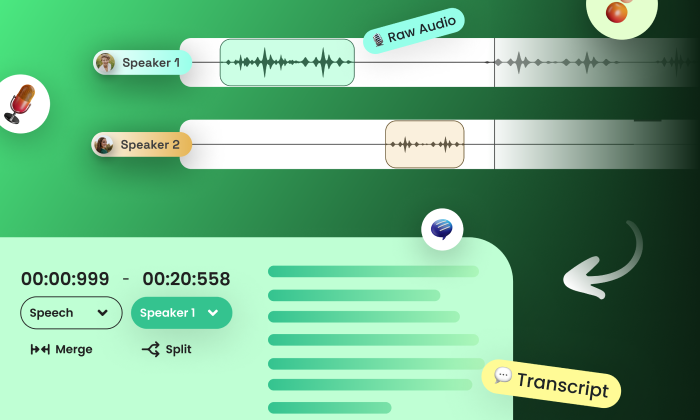What are the main components of a doctor dictation dataset?
Speech Recognition
Healthcare
Dataset
A doctor dictation dataset is a collection of audio recordings where clinicians verbalize detailed patient care information for chart notes. These datasets play a critical role in developing AI technologies like medical speech recognition systems, enhancing clinical decision support, and streamlining electronic medical records (EMRs). Understanding the main components of these datasets is key for teams working on AI-driven healthcare solutions.
Key Audio Features for Dictation Datasets
The audio component is fundamental to a doctor dictation dataset and involves several important characteristics:
- Format and Quality: Recordings are typically in mono WAV format with a sample rate of at least 16 kHz and a 16-bit depth, ensuring clarity and precision. For specialized needs, higher fidelity options like 48 kHz and 24-bit are available.
- Duration and Structure: Sessions range from 30 seconds to 6 minutes, capturing short to extended dictations. This range supports diverse training data by incorporating natural pauses, corrections, and optional punctuation cues.
- Recording Environment: Ideally, these recordings are made in quiet clinical settings. Allowing light background noise can enhance model robustness, provided it doesn't introduce protected health information (PHI).
Diverse Clinical Content in Dictation Datasets
Content diversity is crucial for a dataset's relevance and applicability across different medical fields:
- Clinical Specialties: Recordings should span various fields such as internal medicine, pediatrics, and cardiology, covering routine check-ups, acute conditions, and post-operative care. This diversity ensures the dataset's adaptability for different AI applications.
- Language and Terminology: While primarily in English, datasets may include multiple languages to represent a wide range of accents and dialects. Medical terminology is dense, specific to each specialty, and essential for accurate AI training.
Contributors and Data Anonymization
The quality and authenticity of the dataset rely on the contributors' expertise and adherence to privacy standards:
- Clinician Involvement: Ideally, licensed healthcare professionals record the dictations, ensuring clinical accuracy. Contributors must consent and comply with confidentiality agreements to protect PHI.
- Anonymization Standards: Compliance with regulations like HIPAA and GDPR is vital. This is achieved by instructing contributors to avoid specific identifiers and using de-identification methods to eliminate any remaining risks.
Metadata and Annotation for Enhanced Usability
Rich metadata significantly enhances the dataset's usability for AI applications:
- Metadata Elements: Each recording comes with detailed metadata including anonymized speaker ID, specialty, device type, and recording environment. This helps organize and analyze the dataset effectively.
- Annotation Layers: Optional annotations for named entities, like medications and diagnoses, further enhance the dataset. These tags streamline workflows for medical coding and clinical decision-making.
Ensuring Quality and Compliance in Dictation Datasets
Maintaining high-quality standards is essential for the dataset's effectiveness in training AI models:
- Quality Control Measures: A rigorous quality assurance pipeline includes automated audio checks and human reviews by medical linguists, targeting high transcription accuracy. The goal is often a word-level accuracy of 98% for cleaned transcripts.
- Compliance Checks: Stringent compliance processes ensure the dataset adheres to legal and ethical standards, safeguarding against PHI exposure.
Conclusion
A doctor dictation dataset is composed of critical elements: high-quality audio recordings, diverse clinical content, contributions from qualified professionals, detailed metadata, and robust quality assurance processes. Each component is vital in developing accurate AI systems while meeting compliance requirements. By understanding these elements, teams can effectively design and utilize these datasets for healthcare applications.
Smart FAQs
Q: How do doctor dictation recordings differ from patient-doctor conversations?
A: Dictations are structured, single-speaker recordings focused on documenting clinical notes. In contrast, patient-doctor conversations are interactive, involving dialogue and broader linguistic variability.
Q: How is the quality of a doctor dictation dataset ensured?
A: Quality is maintained through automated audio checks and human transcription reviews, ensuring high accuracy and compliance with standards. This approach ensures reliable data for AI training.
What Else Do People Ask?
Related AI Articles
Browse Matching Datasets
Acquiring high-quality AI datasets has never been easier!!!
Get in touch with our AI data expert now!




-data-collection/thumbnails/card-thumbnail/top-resources-to-gather-speech-data-for-speech-recognition-model-building.webp)



